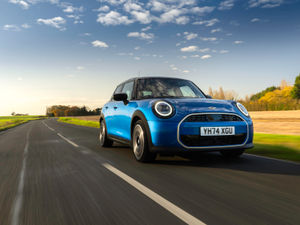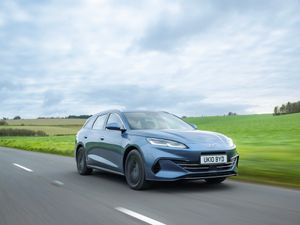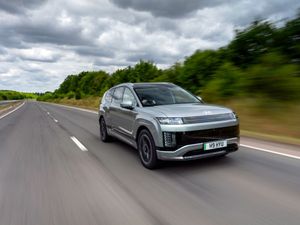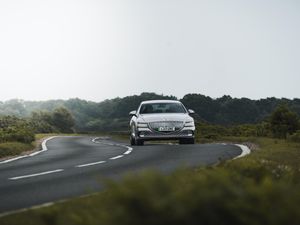First Drive: Is the new Lexus NX a genuine contender in the premium SUV class?
The Lexus NX is back with a second generation. Darren Cassey finds out if it can take the fight to BMW, Volvo and others.
What is it?

Given the fact that Lexus was pushing its ‘self-charging hybrids’ before most of its rivals had even considered electrification, you might be surprised to learn that this new NX is the first time the brand has offered a plug-in hybrid powertrain (PHEV).
This second-generation Lexus NX has arrived with the firm claiming it’s 95 per cent new. It might look similar to its predecessor from the outside, but a lot of work has gone into the mid-sized SUV in an attempt to make it more competitive with premium rivals from the likes of Volvo and BMW.
The new NX is also offered as a self-charging hybrid, but it’s the PHEV we’re testing today. This is Lexus’ best-selling model in the UK, so a new one is a pretty big deal.
What’s new?

There’s a new-look exterior that’s pretty similar to the old one, some new powertrains, an improved interior as well as the promise of a more enjoyable driving experience.
One of the key changes for anyone who’s used Lexus’ frustrating infotainment system is that the NX debuts a new version that sits within a redesigned interior. The whole car is also slightly larger than the old model and built on a new platform that Lexus reckons will make it better to drive.
Lexus is also well-known for building safe, reliable cars, so it’s also keen to point out that the new NX gets extra safety and convenience technology.
What’s under the bonnet?

There are two powertrain options available, called 350h and 450h+, with both having a four-cylinder petrol engine at their core, paired to electric motors on the front and rear axle. The end result is outputs of 241bhp and 305bhp respectively, with the former being the regular hybrid and the latter the PHEV.
The 350h is slightly slower, taking 7.7 seconds to complete the 0-60mph sprint, compared with 6.3 seconds in the PHEV. The battery is also considerably bigger in the PHEV at 96kwh compared with 70, which gives it an impressive 47-mile electric-only range.
On our test with the car, though, we were left a little disappointed by the economy figures. Official measurements for PHEVs are pointless (the NX reads up to 314mpg, for example), but while we managed 53 per cent of our journey on electric-only power, our overall consumption in mixed driving conditions was about 36mpg. That means you really need to keep that battery topped up, because the petrol engine is thirsty.
What’s it like to drive?

First impressions behind the wheel are very good. Our test car is in F-Sport trim with big alloys, but it’s immediately apparent these don’t result in a poor low-speed ride quality. Couple this with the smooth, silent operation of the electric motors and the NX feels incredibly refined from the off.
When the engine does cut in it can be quite gruff, lacking the subtle refinement of other PHEVs. However, modern CVT gearboxes have largely moved on from the unpleasant droning and bizarre acceleration characteristics of old, meaning it’s no longer a weak link in the chain.
How does it look?

In a segment where safe styling is the norm, the Lexus NX continues to be a breath of fresh air. The firm’s angular design ethos and imposing front grilles make it stand out from the crowd, something that’s particularly true of this model.
The spindle grille has been tweaked to be more upright, which has the benefit of allowing more air into the engine bay, while the chrome frame has been ditched. These sharp lines flow into a muscular rear end that makes the car look fairly compact, in contrast with the massive front.
Perhaps the only criticism is that the styling has simply evolved, looking more like a mid-life refresh than a new generation.
What’s it like inside?

While the exterior feels like mild evolution, there are more obvious changes inside. The cockpit is familiarly Lexus, but feels like the overly complicated cabins of previous models might be a thing of the past. The good news is that the awful trackpad has gone, and in its place is a high-resolution touchscreen (9.8-inch as standard or 14-inch on higher-spec trims).
It’s a big step up, with clear graphics and quick responses to touch. It’s not perfect, with some odd design choices – you can’t quick-scroll menus such as radio station lists, you have to flick one ‘screen’ at a time, for example – but overall it’s a big improvement.
There’s still that indescribable something that leaves it just behind class leaders like BMW and Volvo, but it offers a genuinely interesting alternative. The driving position is great, the materials all feel high quality and there’s plenty of space for passengers.
What’s the spec like?

There are three trims available, called NX, F Sport and Takumi. Even the entry level model is well-equipped – starting at £38,300 for the 350h and £48,800 for the 450h+, this feels like the best value option.
Standard equipment includes extensive safety equipment, dual-zone climate control, reversing camera, heated front seats, LED headlights and 18-inch alloy wheels. There are also three option packs, and the 450h+ comes with the Preium Pack as standard, which adds privacy glass, heated steering wheel, wireless charger and more.
F Sport models start at £47,300 (350h) or £54,800 (450h+) and include adaptive variable sports suspension, an extra drive mode, sports steering wheel, F Sport leather upholstery and 20-inch alloy wheels. These models also come with the Premium Plus pack as standard, which adds LED cornering lights, larger touchscreen display and adaptive high-beam.
These models also have an optional Takumi pack, which adds a Mark Levinson sound system, head-up display and sunroof (450h+) or panoramic roof (350h).
Finally, the top-spec NX is called Takumi and starts from £51,800 (350h) or £57,800 (450h+) and includes fully automated parking, the stereo upgrade, a ‘card key’, leather upholstery and 20-inch alloy wheels.
Verdict

Lexus has done an admirable job over the past few decades, establishing itself as a genuine alternative to the established premium marques like BMW and Mercedes-Benz. The new NX only continues that, and is arguably the closest yet to those bigger brands’ rival offerings.
It looks great, the interior has moved on and the infotainment system no longer lets the side down. It’s also pretty comfortable to drive, and if you keep the battery topped up, should have low running costs over a short commute or school run.
From a purely rational comparison, it’s difficult to recommend the NX over, say, a Volvo XC60 or an Audi Q5. However, for those who want a less obvious, more interesting choice, the NX won’t disappoint.





